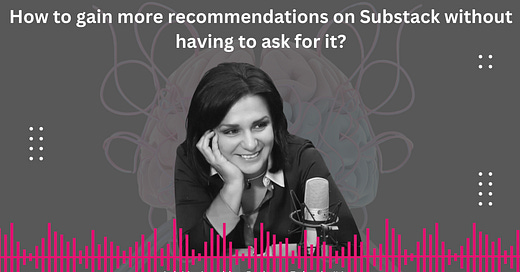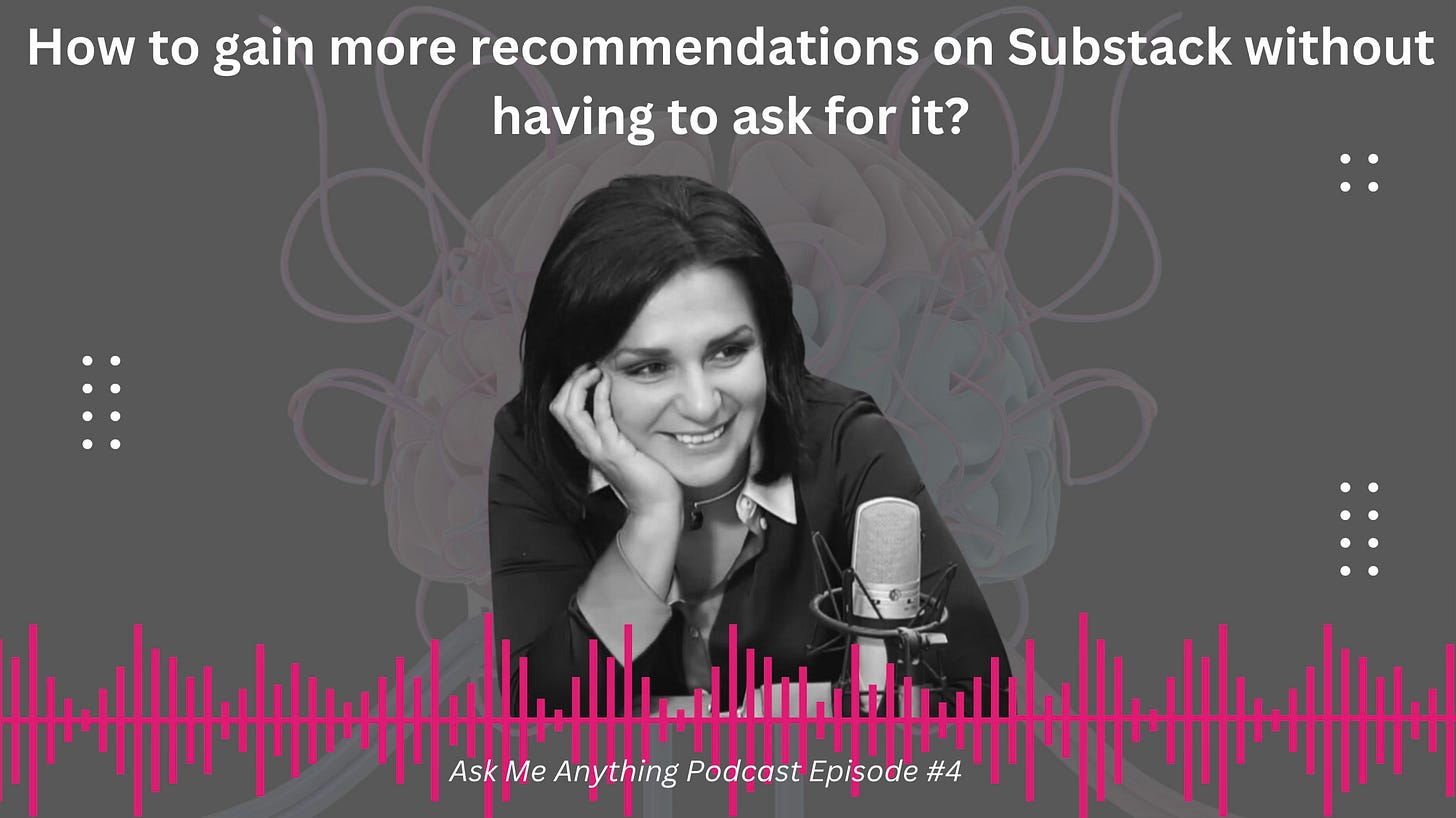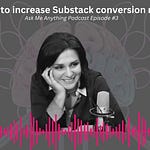Hello, everyone. Welcome to the fourth episode of my Ask Me Anything podcast.
Every month I collect pressing questions about growing and monetizing a newsletter on Substack, and I answer them here.
If you want to have your question answered, reach out to me in the chat or post it here:
Here are the questions for today:
How do you manage to produce so much along your 9-5? Are you superhuman
How did you pick your audience and attract them to your offer?
What happens if your content is for entertainment purposes and doesn’t “solve a problem” in the traditional sense?
How to create a Substack strategy?
How do you often post Notes? Is this like X (tweet) or Threads post? Do we have a way to automate posting Notes?
How do you figure out what to write in Notes?
Should I create a second publication for another topic?
People say- audience - first. Put out contents that audience want to see- something I myself would be curious about. If I were to start with my offer. How good or bad is it to change the foundation after parsing through reader’s engagement?
How to gain more recommendations on Substack without having to ask for it?
Do you ever worry about inbox fatigue from your readers?
And here are the answers in case you want to read:
1. How do you manage to produce so much along your 9-5? Are you superhuman?
I wish I was superhuman. But no—I'm just strategic. And stubborn.
Yes, I struggle to get up early.
Yes, I have days where I want to do nothing.
Yes, I still hit “publish.”
Here’s what actually makes it possible:
1. I Use AI, but Not Mindlessly
AI helps me draft, structure, and speed things up.
But I don’t rely on it to think for me. I use it like a co-writer, not a ghostwriter.
It’s a tool, not a replacement.
2. I Don’t Wait for the Mood to Write
I don’t “feel like writing” every day.
I write anyway.
Because if you only write when you're in flow... you’ll never publish consistently.
3. I Focus on Systems, Not Motivation
Motivation is unreliable.
Systems don’t care how you feel.
I have templates. I reuse structure. I keep idea banks.
So even when I’m tired, I can still create.
4. I Built an Achiever Mindset
If you want to know what actually makes this work?
It’s this: I treat content creation like a quest, not a chore.
I just published Chapter 1 of my Substack Quest – Mindset of the Achiever.
I break down the exact mindset, routines, and strategies I use to show up daily.
Because this isn’t about being “talented” or “disciplined.”
It’s about learning how to finish what you start.
So no—I'm not superhuman.
But I’ve built habits that feel like a superpower.
And if I can do it with a 9–5, you can too.
2. How did you pick your audience and attract them to your offer?
I didn’t start with the offer. I started with the audience.
That’s the part most people get wrong.
They come up with an idea, try to package it, and then go searching for someone who might want it.
That’s wrong on so many levels. .
I did it the other way around.
I asked:
· Who do I want to write for?
· Who do I understand deeply?
· Whose problems do I know how to solve, because I’ve lived them?
Once I had my people, I built my offer for them.
Not the other way around.
So how did I attract them?
I talked to them.
Not to people who I engage with.
Not to people who I collaborate with.
But to my ideal buyers.
Everywhere.
In Notes.
In posts.
In comments.
I showed them I get it.
I didn’t try to convince them to buy something random.
I showed up with the exact solution they were already searching for.
That’s what proper positioning does.
It aligns what you sell with who actually needs it.
And when you do that well, you don’t chase an audience.
They come to you.
3. What happens if your content is for entertainment purposes and doesn’t “solve a problem” in the traditional sense?
Here’s the truth.
Even entertainment solves a problem.
It solves boredom.
It solves loneliness.
It gives people an escape, a laugh, a story to hold onto when real life feels too heavy.
What makes fiction so relatable?
Emotions.
So if your content makes people feel something, you’re already solving something.
That said, here’s the key:
Entertainment converts when it’s tied to value.
Value can look like a fresh perspective.
It can look like emotional relief.
It can even look like someone saying, “Finally, someone said it.”
But if you’re creating just for fun, with no deeper intent?
You’ll probably want to monetize through sponsorships, merch, and ads.
If you’re trying to build a business?
Then layer the entertainment with solutions.
Make people feel something, but also think something and do something.
Because people will pay for content that makes their day better.
But they’ll pay even faster for content that makes their life easier.
Entertainment can absolutely sell.
You just have to ask:
What’s the need behind the fun?
And who’s willing to pay for it?
4. How to create a Substack strategy?
You don’t start with a logo.
You don’t start with a clever name.
You start with positioning.
Ask yourself two simple questions:
What problem do I solve?
Who do I solve it for?
If you don’t know the answer to those, stop everything.
Because without positioning, every post is a guess.
Once that’s clear, figure out this:
How do I solve that problem differently than others?
That’s your edge.
Your twist.
The reason someone will choose you instead of the twenty other writers in your niche.
Then comes the next layer:
Build credibility.
If you don’t have a big audience or track record yet, start by documenting your process.
Share your wins, your behind-the-scenes, your “I figured this out the hard way” stories.
That creates trust.
Trust builds belief.
Belief turns readers into subscribers.
Once that’s working, you build your offer.
What are you selling?
Why is it valuable?
What’s behind the paywall that they can’t get anywhere else?
Then finally create your growth action plan.
That includes Notes.
Recommendations.
Engagement.
CTAs.
And consistent posting.
This whole system?
I call it the Substack Quest.
It’s not just one strategy.
It’s the full roadmap.
Positioning.
Product.
Growth.
Monetization.
Retention.
If you're missing one of those, you're leaving subscribers—and money—on the table.
5. How do you often post Notes? Is this like X (tweet) or Threads post? Do we have a way to automate posting Notes?
I post 3 to 10 Notes a day.
Yes, every day.
Is it like a tweet or a Threads post?
Exactly.
It’s short-form, real-time, low-pressure.
It’s like dropping insights into the room and seeing who picks them up.
Notes are where attention happens.
They’re not just “extras”. They’re the engine.
This is where new people discover you.
This is where your current readers stay connected.
This is where conversions begin.
Do I automate them?
Nope. Substack doesn’t offer API access yet.
So no automation, no scheduling.
But I do cheat a little.
I use my own VIRAL Notes Writer GPT.
It helps me come up with ideas and format posts fast.
With it, I can write a full day’s worth of Notes in about 15 minutes. It’s available for my paid subscribers. Many of them got viral Notes recently. It’s pure gold.
6. How do you figure out what to write in Notes?
Easy.
I take what I’m already writing in my newsletter and I break it into smaller pieces.
That’s it.
Same ideas.
Same themes.
Just shorter, punchier, more casual.
If your newsletter is about storytelling, mindset, writing, parenting, whatever?
Then your Notes should reflect that too.
Think of Notes as the appetizer.
The full post is the meal.
Notes are what get people to sit down at the table.
For me they are the entry point of my funnel.
I get tons of ideas for Notes from my audience. I use my custom VIRAL Notes Writer GPT to turn them into punchy pieces that bring me subscribers – both free and paid.
Write them like you talk. Or use my Notes GPT.
Post them like you don’t care.
Because that’s how Notes work best.
7. Should I create a second publication for another topic?
It depends on who your audience is, not what your topics are.
If the topics are connected, or if the same type of reader would be interested in both—
then keep it under one publication.
One clear brand. One list. Less friction.
But if the topics are completely different?
And the people who care about Topic A have zero interest in Topic B?
Then yes, consider splitting.
Here’s the rule:
If your content starts confusing or alienating the people who originally subscribed, you’re diluting your growth.
So ask yourself:
Would my current readers also love this other topic?
Or am I starting to write for someone else entirely?
If the audience overlaps then combine.
If it doesn’t then separate.
Always build for readers, not categories.
8. People say- audience - first. Put out contents that audience want to see- something I myself would be curious about. If I were to start with my offer. How good or bad is it to change the foundation after parsing through reader’s engagement?
Here’s the truth:
Starting with an offer first is good. But starting with the audience first is smarter. The best approach: start with both. Build your offers based on your audience needs.
Because if you build an audience without a clear offer in mind, you risk attracting the wrong people.
People who love your content… but have zero intention of ever paying for anything.
So yes, you start by thinking about your audience.
That’s the foundation.
And once that’s in place, then you pay attention to engagement.
You test.
You refine.
You course-correct.
But you don’t change the foundation just because a few posts got more clicks.
Because engagement is great—but conversion is the goal.
Here’s the danger if you don’t:
You grow fast, but you can’t monetize.
You end up with the wrong crowd for the right product.
9. How to gain more recommendations on Substack without having to ask for it?
Simple.
You give them first.
It’s the universal law of attraction: you give in order to receive.
Substack is no exception.
When you recommend another writer, Substack sends them an automatic email asking them to recommend you back.
You don’t have to ask.
You don’t have to beg.
You just have to give first.
Go recommend people you like.
Some will recommend you back.
Some won’t.
But you’ll grow either way.
Because Substack is watching.
The more active and generous you are in the ecosystem, the more the algorithm favors you.
No begging. No awkward DMs.
Just show up, support others, and let the system do its thing.
10. Do you ever worry about inbox fatigue from your readers?
Honestly? No.
Here’s why…
Most of your readers are already drowning in emails, but that’s exactly why you need to show up more, not less.
Because if you only post once in a while, they’ll forget who you are.
They’ll miss your name in the inbox.
And when you do send something, they’re more likely to ignore it.
Now, let’s be real: not everyone opens every email.
But that’s not a problem.
That’s just how inboxes work.
The solution isn’t fewer emails.
The solution is more good emails.
More touchpoints.
More value.
More chances to connect.
I send twice a week, and I know some creators who send daily.
They’re doing just fine, because their content is aligned, valuable, and expected.
So instead of worrying about inbox fatigue, ask this:
Are you showing up with something worth opening?
Because when you are?
More emails = more attention = more trust = more conversions.
Simple as that.
And with that let’s finish for today’s episode. I hope you enjoyed it!
See you next time!
Stay Unplugged!
Yana
P.S. This is my real voice, professionally cloned with ElevenLabs so that I don’t have to record everything. It saved me tons of time!
It does sound like me, isn’t it? I’m so impressed! I use ElevenLabs to make my voiceovers so that I don't have to do the tedious work of reading and recording and be careful about what I speak.
And it helps a ton in times like this, when I can’t really speak because of being sick with a bad fever.
👉 And if you haven’t already, join the Unplugged community and Kickstart your Substack growth:














Share this post